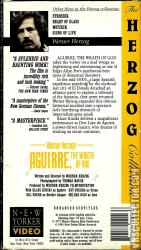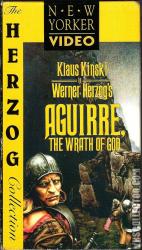Aguirre, The Wrath Of God
Catalog Number
NYV22091
-
Primary Distributor (If not listed, select "OTHER")
Catalog Number
NYV22091
Primary Distributor (If not listed, select "OTHER")
Distributor Series
Release Year
Country
94 mins (NTSC)
N/A | N/A | N/A
N/A | N/A
Aguirre, Der Zorn Gottes (1977)
Additional Information
Additional Information
A heartbreaking journey into the heart of darkness.
The most famed and well-regarded collaboration between New German Cinema director Werner Herzog and his frequent leading man, Klaus Kinski, this epic historical drama was legendary for the arduousness of its on-location filming and the convincing zealous obsession employed by Kinski in playing the title role. Exhausted and near to admitting failure in its quest for riches, the 1650-51 expedition of Spanish conquistador Gonzalo Pizarro (Alejandro Repulles) bogs down in the impenetrable jungles of Peru. As a last-ditch effort to locate treasure, Pizarro orders a party to scout ahead for signs of El Dorado, the fabled seven cities of gold. In command are a trio of nobles, Pedro de Ursua (Ruy Guerra), Fernando de Guzman (Peter Berling), and Lope de Aguirre (Kinski). Traveling by river raft, the explorers are besieged by hostile natives, disease, starvation and treacherous waters. Crazed with greed and mad with power, Aguirre takes over the enterprise, slaughtering any that oppose him. Nature and Aguirre's own unquenchable thirst for glory ultimately render him insane, in charge of nothing but a raft of corpses and chattering monkeys. Aguirre, der Zorn Gottes (1973) was based on the real-life journals of a priest, Brother Gaspar de Carvajal (played in the film by Del Negro), who accompanied Pizarro on his ill-fated mission.
Aguirre, the Wrath of God (German: Aguirre, der Zorn Gottes), known in the UK as Aguirre, Wrath of God, is a 1972 West German New Wave adventure art film written and directed by Werner Herzog. Klaus Kinski stars in the title role. The soundtrack was composed and performed by German progressive/Krautrock band Popol Vuh. The story follows the travels of Spanish soldier Lope de Aguirre, who leads a group of conquistadores down the Orinoco and Amazon River in South America in search of the legendary city of gold, El Dorado. Using a minimalist story and dialogue, the film creates a vision of madness and folly, counterpointed by the lush but unforgiving Amazonian jungle. Although based loosely on what is known of the historical figure of Aguirre, the film's story line is, as Herzog acknowledged years after the film's release, a work of imagination. Some of the people and situations may have been inspired by Gaspar de Carvajal's account of an earlier Amazonian expedition, although Carvajal was not on the historical voyage represented in the film. Other accounts state that the expedition went into the jungles but never returned to civilization.
Aguirre was the first of five collaborations between Herzog and the volatile Kinski. The director and the actor had differing views as to how the role should be played, and they clashed throughout the film's production, while Kinski's tantrums terrorized both the crew and the local natives who assisted the production. The production was shot entirely on location, and was fraught with difficulties. Filming took place in the Peruvian rainforest on the Amazon River during an arduous five-week period, shooting on tributaries of the Ucayali region. The cast and crew climbed mountains, cut through heavy vines to open routes to the various jungle locations, and rode treacherous river rapids on rafts built by natives.
Aguirre opened to widespread critical acclaim, and quickly developed a large international cult film following. It was given an extensive arthouse theatrical release in the United States in 1977, and remains one of the director's best known films. Several critics have declared the film a masterpiece, and it has appeared on Time magazine's list of "All Time 100 Best Films". Aguirre’s visual style and narrative elements had a strong influence on Francis Ford Coppola's 1979 film Apocalypse Now.
Release Date: April 3, 1977
Distrib: New Yorker Films
The most famed and well-regarded collaboration between New German Cinema director Werner Herzog and his frequent leading man, Klaus Kinski, this epic historical drama was legendary for the arduousness of its on-location filming and the convincing zealous obsession employed by Kinski in playing the title role. Exhausted and near to admitting failure in its quest for riches, the 1650-51 expedition of Spanish conquistador Gonzalo Pizarro (Alejandro Repulles) bogs down in the impenetrable jungles of Peru. As a last-ditch effort to locate treasure, Pizarro orders a party to scout ahead for signs of El Dorado, the fabled seven cities of gold. In command are a trio of nobles, Pedro de Ursua (Ruy Guerra), Fernando de Guzman (Peter Berling), and Lope de Aguirre (Kinski). Traveling by river raft, the explorers are besieged by hostile natives, disease, starvation and treacherous waters. Crazed with greed and mad with power, Aguirre takes over the enterprise, slaughtering any that oppose him. Nature and Aguirre's own unquenchable thirst for glory ultimately render him insane, in charge of nothing but a raft of corpses and chattering monkeys. Aguirre, der Zorn Gottes (1973) was based on the real-life journals of a priest, Brother Gaspar de Carvajal (played in the film by Del Negro), who accompanied Pizarro on his ill-fated mission.
Aguirre, the Wrath of God (German: Aguirre, der Zorn Gottes), known in the UK as Aguirre, Wrath of God, is a 1972 West German New Wave adventure art film written and directed by Werner Herzog. Klaus Kinski stars in the title role. The soundtrack was composed and performed by German progressive/Krautrock band Popol Vuh. The story follows the travels of Spanish soldier Lope de Aguirre, who leads a group of conquistadores down the Orinoco and Amazon River in South America in search of the legendary city of gold, El Dorado. Using a minimalist story and dialogue, the film creates a vision of madness and folly, counterpointed by the lush but unforgiving Amazonian jungle. Although based loosely on what is known of the historical figure of Aguirre, the film's story line is, as Herzog acknowledged years after the film's release, a work of imagination. Some of the people and situations may have been inspired by Gaspar de Carvajal's account of an earlier Amazonian expedition, although Carvajal was not on the historical voyage represented in the film. Other accounts state that the expedition went into the jungles but never returned to civilization.
Aguirre was the first of five collaborations between Herzog and the volatile Kinski. The director and the actor had differing views as to how the role should be played, and they clashed throughout the film's production, while Kinski's tantrums terrorized both the crew and the local natives who assisted the production. The production was shot entirely on location, and was fraught with difficulties. Filming took place in the Peruvian rainforest on the Amazon River during an arduous five-week period, shooting on tributaries of the Ucayali region. The cast and crew climbed mountains, cut through heavy vines to open routes to the various jungle locations, and rode treacherous river rapids on rafts built by natives.
Aguirre opened to widespread critical acclaim, and quickly developed a large international cult film following. It was given an extensive arthouse theatrical release in the United States in 1977, and remains one of the director's best known films. Several critics have declared the film a masterpiece, and it has appeared on Time magazine's list of "All Time 100 Best Films". Aguirre’s visual style and narrative elements had a strong influence on Francis Ford Coppola's 1979 film Apocalypse Now.
Release Date: April 3, 1977
Distrib: New Yorker Films
Related Links






Comments0
Login / Register to post comments